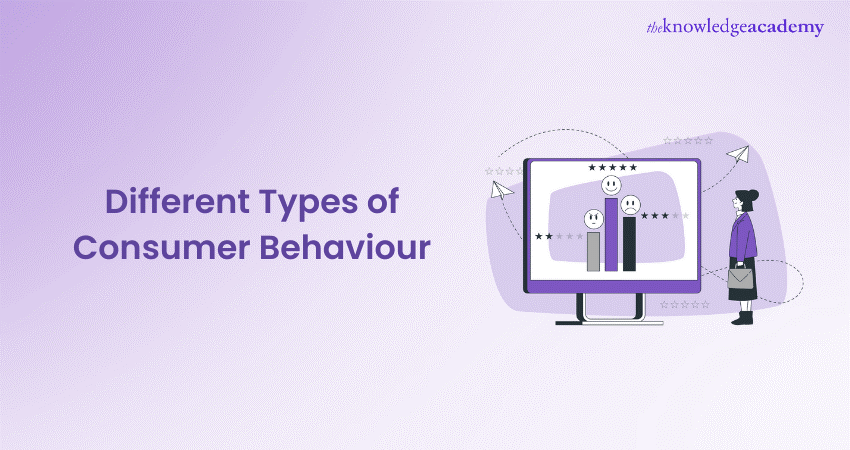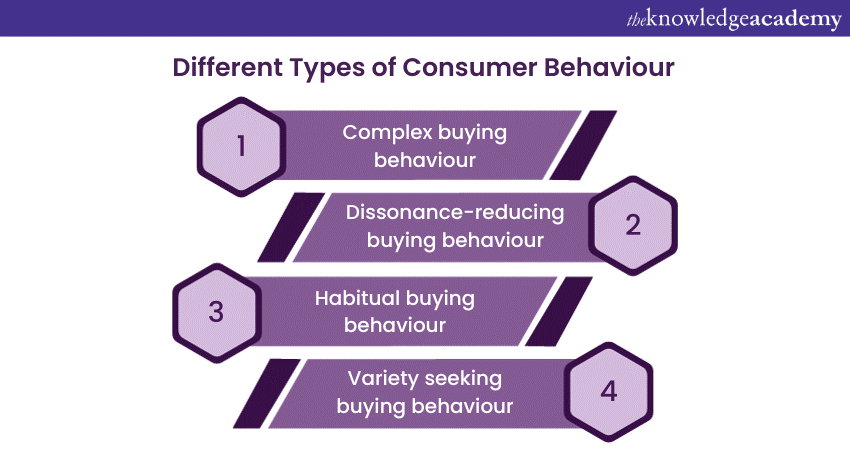We may not have the course you’re looking for. If you enquire or give us a call on 01344203999 and speak to our training experts, we may still be able to help with your training requirements.
Training Outcomes Within Your Budget!
We ensure quality, budget-alignment, and timely delivery by our expert instructors.

Have you ever pondered the various Types of Consumer Behaviour that influence our choices when it comes to making purchases? The world of Consumer Behaviour is a puzzle, and what drives us to choose one product over another is a mystery waiting to be unravelled. Explore the various Types of Consumer Behaviours, from impulse buys to eco-conscious choices, uncovering the drivers behind individual decisions.
Table of Contents
1) What are the different Types of Consumer Behaviour?
a) Complex buying behaviour
b) Dissonance-reducing buying behaviour
c) Habitual buying behaviour
d) Variety seeking buying behaviour
2) Conclusion
What are the different Types of Consumer Behaviour?
Knowing how consumers make choices is crucial for businesses in the ever-changing world of buyer decision-making. Here, we'll explore different Types of Consumer Behaviour, explaining the things that influence how people decide what to buy.
1) Complex buying behaviour
Complex buying behaviour arises, especially when consumers are purchasing costly items. In these less frequent transactions, consumers are highly engaged in the decision-making process, often conducting thorough research before committing to a purchase.
When consumers are buying an expensive or unfamiliar product, their behaviour changes significantly. When the risk associated with the purchase is high, consumers seek advice from friends, family, and experts before reaching a decision. For instance, buying a car for the first time is a major decision involving considerable economic risk. Consumers contemplate factors like the car's appearance, how friends and family will react, and the potential impact on their social status.
In the context of complex buying behaviour, the consumer undergoes a learning process. They form beliefs about the product, develop attitudes, and then make a considered purchase choice.

2) Dissonance-reducing buying behaviour
In situations where consumers engage in dissonance-reducing buying behaviour, their level of involvement is quite high. This could be because of high prices and less frequent purchases. Additionally, there are limited options available, and the differences between brands are not very significant. In this scenario, consumers tend to opt for products that are readily accessible.
Consumers, in such cases, might find themselves making decisions with fewer choices, leading to limited decision-making. They end up buying certain products without extensive research, influenced by factors like product availability, time constraints, or budget limitations.
For instance, if a consumer is in need of a new collapsible table for camping, they might quickly choose from the few available brands. Their main considerations are the table's functionality, features, and their budget.
Enhance your marketing prowess with our Marketing Research Masterclass and elevate your strategic skills for business success!
3) Habitual buying behaviour
Habitual Buying Behaviour occurs when a shopper is not very involved in deciding what to buy. In this situation, they notice only a few important differences between brands.
When people purchase items they use every day, they don't think too much. They might choose their favourite brand or the one they regularly use or go for what's in the store or the cheapest option. For instance, when someone buys an energy drink, they often pick the flavour they like without doing a lot of research. Many products fall into this category, such as chocolates, cakes, juices, and more.
Consumers in this scenario don't stick to a particular brand; there's no loyalty. They don't spend time researching or needing information about these purchases. Habitual buying behaviour is influenced by radio, television, and print media. Additionally, consumers make choices based on how familiar they are with a brand.
Therefore, marketers should use repetitive ads to make the brand well-known. To encourage consumers to try the product, marketing strategies like price drops and sales promotions should be employed. To attract consumers, marketers should use visual symbols and images in their advertising. Visual ads are easy for consumers to remember and associate with a brand.
Elevate your marketing expertise with our Introduction to Marketing Training – Sign up today and propel your career forward!
4) Variety seeking buying behaviour
In the variety-seeking Consumer Behaviour, consumers aren't highly involved in their choices, and there are noticeable differences between brands. People tend to switch between brands frequently, and because the cost of changing products is low, they might try new things just out of curiosity or to break the routine. Consumers in this category buy various products not because they're unhappy with what they have but mainly because they want to experience different things.
For instance, a consumer might pick a cookie brand with little thought, and the next time, they might choose a different brand for a change in taste. Brand switching happens frequently and without a specific plan. To tackle this Type of Consumer Behaviour, brands need different strategies. The market leader, for instance, will influence habitual buying behaviour by controlling the shelf space and displaying numerous related but different product versions.
Marketers ensure there are enough products available, engage in regular advertising, and offer lower prices, discounts, deals, coupons, and free samples to attract these consumers.
Conclusion
Consumer purchasing choices are influenced by Consumer Behaviour, and there are significant variations in behaviour when buying a car compared to purchasing snacks. Marketers must exercise careful observation when promoting products to different Types of Consumer Behaviour. We hope that this blog helps you understand the different Types of Consumer Behaviour.
Supercharge your marketing skills with our comprehensive Marketing Courses – Join now for a strategic leap in your marketing career!
Frequently Asked Questions
Upcoming Digital Marketing Resources Batches & Dates
Date
 Consumer Behaviour Course
Consumer Behaviour Course
Fri 24th May 2024
Fri 28th Jun 2024
Fri 26th Jul 2024
Fri 9th Aug 2024
Fri 6th Sep 2024
Fri 18th Oct 2024
Fri 8th Nov 2024
Fri 13th Dec 2024







 Top Rated Course
Top Rated Course



 If you wish to make any changes to your course, please
If you wish to make any changes to your course, please


